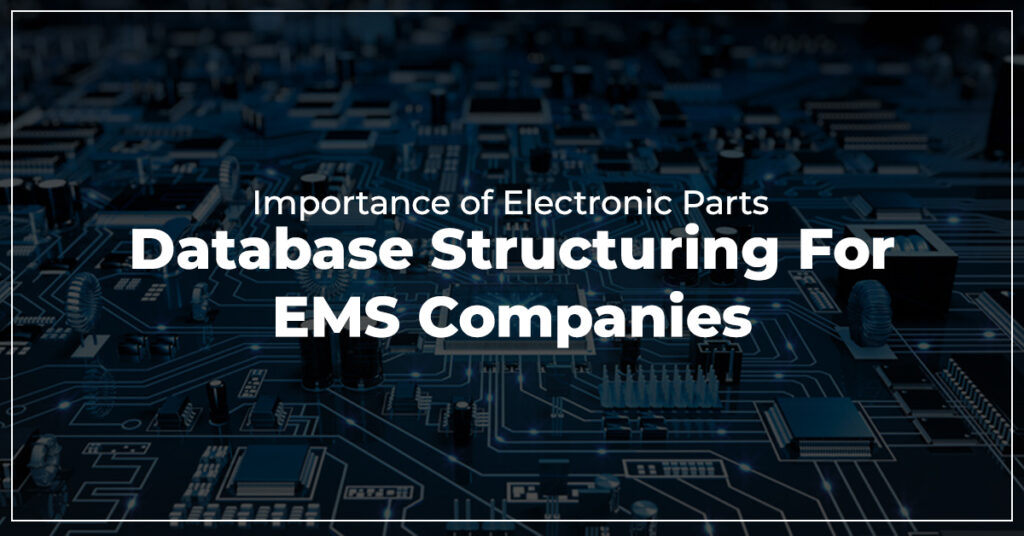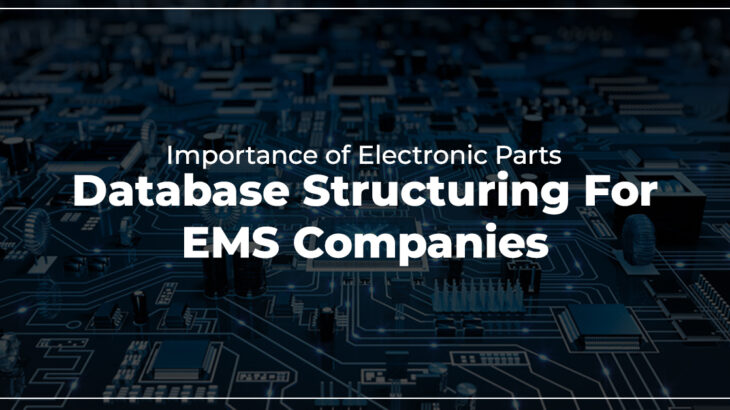
Electronic Parts Database Structuring is crucial for Electronics Manufacturing Services (EMS) companies for several important reasons. Component data is the most critical asset an EMS company owns. Ensuring that this data is structured and maintained well is a critical need for a modern age EMS company to be competitive in the market. Let us look at the importance of this data:
Inventory Management:
EMS companies deal with a vast array of electronic components and parts. A well-structured parts database helps them manage and track their inventory efficiently. This includes knowing what parts are available, their quantities, lead times, and where they are located within the facility.
Sourcing and Procurement:
A structured database assists in the sourcing and procurement process. It allows EMS companies to identify reliable suppliers for electronic components, compare prices, and track historical data on purchases, enabling better negotiation and cost management.
Quality Control:
The quality and authenticity of electronic components are paramount in electronics manufacturing. A structured database can store information related to quality standards, component specifications, and certification data. This ensures that the parts used meet the necessary quality requirements.
BOM Management:
Bill of Materials (BOM) is a critical aspect of electronics manufacturing. A well-structured parts database allows EMS companies to create and manage BOMs efficiently, ensuring that the correct components are used in the assembly process.
Product Lifecycle Management:
Electronic components have lifecycles, and many become obsolete over time. A structured database keeps track of component lifecycle information, helping EMS companies avoid using obsolete parts and finding alternatives when necessary.
Traceability:
Traceability is essential, particularly in industries like aerospace and healthcare, where product recalls can have severe consequences. A structured database helps maintain traceability records, allowing companies to track the origin of each component and its usage in specific products.
Supply Chain Resilience:
In the face of supply chain disruptions, EMS companies need to have a clear understanding of their component inventory. A well-structured database enables them to quickly identify potential shortages or bottlenecks and take proactive measures to mitigate risks.
Design Collaboration:
EMS companies often collaborate with their customers on product designs. A structured database can facilitate this collaboration by providing a shared platform for design engineers to access component data and make informed decisions.
Cost Management:
Managing costs is a critical aspect of any business. A structured parts database allows EMS companies to analyze cost data, compare prices from different suppliers, and optimize their component procurement strategies.
Regulatory Compliance:
In industries like medical devices and automotive, regulatory compliance is vital. A structured database can help EMS companies ensure that they are using components that meet industry-specific regulations and standards.
Efficiency and Productivity:
A well-structured database streamlines various processes within an EMS company, leading to increased efficiency and productivity. This includes reducing the time and effort required to search for components, create BOMs, and manage inventory.
Data Security and Backup:
A structured database provides a central repository for sensitive component and supply chain data. EMS companies can implement data security measures to protect this information and establish backup and recovery procedures to safeguard against data loss.
In summary, electronic parts database structuring is fundamental to the success of EMS companies. It impacts various aspects of their operations, from managing inventory and procurement to ensuring product quality, compliance, and resilience in the face of supply chain challenges. It ultimately leads to improved efficiency, cost management, and customer satisfaction.
Key criteria in structuring an electronic component database for an EMS Company
Structuring an electronic component database for an Electronics Manufacturing Services (EMS) company requires careful consideration of various criteria to ensure efficiency, accuracy, and effectiveness in managing electronic components. Here are key criteria and considerations for structuring such a database:
Data Fields and Attributes:
Define a comprehensive set of data fields for each electronic component entry, including part number, description, manufacturer, supplier, datasheet, lifecycle status, lead time, pricing, and compliance information.
Include fields for traceability data, such as lot numbers and date codes.
Consider fields for parametric data (e.g., voltage, current, frequency) and physical characteristics (e.g., package type, size, weight).
Classification and Categorization:
Implement a hierarchical classification system that categorizes components by type (e.g., resistors, capacitors, microcontrollers) and subcategories (e.g., SMD resistors, ceramic capacitors).
Use standardized naming conventions to improve search and retrieval.
Vendor and Supplier Information:
Store detailed information about approved vendors and suppliers, including contact details, certifications, and performance ratings.
Maintain records of purchase history, price agreements, and lead times with each supplier.
Lifecycle Management:
Track the lifecycle status of each component (e.g., active, end-of-life, obsolete).
Set up alerts for end-of-life notifications to ensure timely replacement with suitable alternatives.
Cross-References and Alternatives:
Record cross-references for components that can be substituted for one another.
Include information on suggested alternatives in case a component becomes unavailable.
Quality and Compliance Data:
Include data related to quality standards, compliance with industry regulations, and certifications.
Store information on testing and inspection results for each component, especially in industries with strict quality requirements.
Inventory Management:
Maintain real-time inventory levels and locations.
Implement tracking of minimum stock levels and reorder points to avoid shortages.
Record the date of receipt and lot information for components in stock.
Bill of Materials (BOM) Integration:
Facilitate the creation and management of BOMs by linking components in the database to specific projects or products.
Allow for version control and change management of BOMs.
Data Security and Access Control:
This data resides inside applications like ERP, quote management systems, procurement systems and financial systems. It is important to
Ensure robust data security measures to protect sensitive component data.
Implement access control to restrict database access to authorized personnel only.
Search and Retrieval:
Whichever system this data resides, the ability to search and retrieve will depend on the structuring of the database. Design an intuitive and efficient search system, allowing users to search by various criteria, including part number, description, category, and supplier.
Incorporate filtering and sorting options to simplify component selection.
Data Import and Export:
With each new project new data coming in to the system and parts getting removed from the system is part of the process. Enable data import and export in common formats (e.g., CSV, Excel) to facilitate data exchange with suppliers and customers and integration with other software systems.
Reporting and Analytics:
Develop tools for generating reports on component availability, usage, cost analysis, and inventory turnover.
Use analytics to identify trends, optimize procurement, and manage component lifecycles.
Backup and Disaster Recovery:
Implement regular data backups and disaster recovery procedures to protect against data loss.
Scalability and Flexibility:
Design the database to accommodate future growth and changes in requirements, such as new component types or additional data fields.
Regulatory and Compliance Considerations:
Comply with industry-specific regulations and standards, such as RoHS, REACH, or ITAR, as applicable to your business.
Training and Documentation:
Ensure that employees are properly trained in using the database and provide comprehensive documentation and user guides.
Continuous Maintenance and Updates:
Regularly update the database with new component information, supplier details, and lifecycle status changes.
Structuring an electronic component database effectively is an ongoing process that requires careful planning, continuous maintenance, and adaptation to the evolving needs of the EMS company. It plays a vital role in optimizing supply chain operations, ensuring product quality, and achieving cost-efficiency.
Sunstream’s component engineering team has assisted several EMS companies to structure their component database by our master data services. We can ensure that your component data is free of issues like wrong part number, obsolete parts, internal part number errors etc. We generally see an inventory reduction of 6%-10% by our master data cleansing services to most EMS companies. Our ROHS compliance services, Conflict mineral compliance services will also add value to ensure that you are able to manage compliance of your parts and suppliers to different regulations in the industry. Talk to us today to understand how Sunstream can help you improve the master data quality and save real dollars in inventory.




 +1.585.935.7123
+1.585.935.7123 +91-804-148-6861
+91-804-148-6861